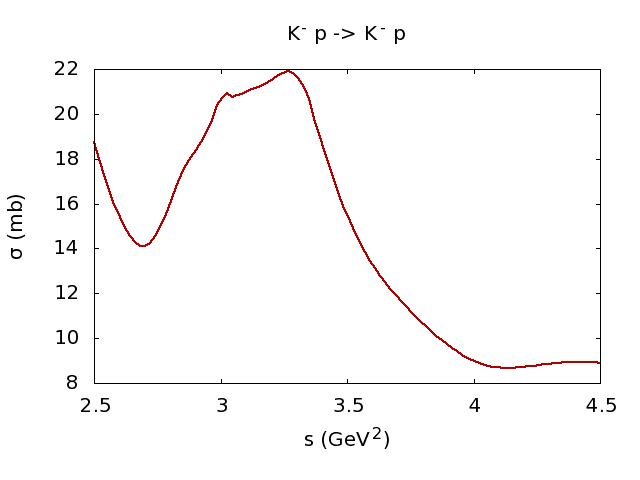We present the codes and the online webpage for the calculation of the total cross section for the following reactions: \begin{alignat}{6} K^-p\to K^-p \, , \,& K^-p\to\bar{K}^0n \, ,\, & K^-p\to\pi^0 \Lambda \, , \, & K^-p\to\pi^- \Sigma^+ \, ,\, & K^-p\to\pi^+ \Sigma^- \, , \; & K^-p\to\pi^0 \Sigma^0 \, . \notag \end{alignat}
Fortran Code
- Total Cross Section Fortran code and input: zip file
- Contact person: Cesar Fernandez-Ramirez
- Last update: September 2015
- Zip File Content:
- README file: README.tex and README.pdf
- Fortran Source File: knxsecf.f
- Parameter files (contain the parameters for each partial wave):
- parameters.s01.inp
- parameters.p01.inp
- parameters.p03.inp
- parameters.d03.inp
- parameters.d05.inp
- parameters.f05.inp
- parameters.f07.inp
- parameters.g07.inp
- parameters.s11.inp
- parameters.p11.inp
- parameters.p13.inp
- parameters.d13.inp
- parameters.d15.inp
- parameters.f15.inp
- parameters.f17.inp
- parameters.g17.inp
- Input File: file.inp
- The first line indicates the process, the options are:
- $K^-p\to K^-p$: prk-toprok-
- $K^-p\to\bar{K}^0n$: prk-toneuk0
- $K^-p\to\pi^0 \Lambda$: prk-tolapi0
- $K^-p\to\pi^- \Sigma^+$: prk-tos+pi-
- $K^-p\to\pi^+ \Sigma^-$: prk-tos-pi+
- $K^-p\to\pi^0 \Sigma^0$: prk-tos0pi0
- The second line indicates the fixed kinematical variable, the options are:
- $s$ (GeV$^2$): 1
- $p_{lab}$ (GeV): 2
- $E_{lab}$ (GeV): 3
- The third line indicates the initial value of the kinematical variable.
- The fourth line indicates the final value of the kinematical variable.
- The fifth line indicates the the amount of points to calculate. There is a limit of 1000 points. It can be changed modifying variable max_data_points=1000 in module resonancesizes.
- $s \in \left[2.1 , 5.0 \right]$ GeV$^2$
- $p_{lab}\in \left[0.164 , 2.0 \right]$ GeV
- $E_{lab}\in \left[0.52 , 2.07 \right]$ GeV
Example of input file (file.inp):
prk-toprok- 1 2.5 4.5 100
Online version
The online version of the code is the same as the one available for download except for some built-in functionalities aimed to allow the webpage to produce nicer plots. The webpage has integrated some restrictions in the inputs through drop-down menus, kinematical ranges and number of points to calculate. Depending on the kinematical variable used as input the available ranges are:
Output
The online and the downloadable versions produce an output file (output.txt) which contains five columns:
-
(i) $s$ (GeV$^2$),
(ii) $~E_{lab}$ (GeV),
(iii) $~p_{lab}$ (GeV),
(iv) the center of mass incoming momentum squared $q^2$ (GeV$^2$), and
(v) total cross section in milibarn,
Run online version of the code
The path is $rootPath
"; chdir('KNscattering/KNXsec'); // because the execution write files // in the current directory $rootPath2 = getcwd(); $file = fopen("file.inp","w"); // open file fwrite($file,$reaction ."\n"); // print fwrite($file,$inputkin ."\n"); fwrite($file,$emin ."\n"); fwrite($file,$emax ."\n"); fwrite($file,$npoints ."\n"); // end print fclose($file); // close file exec('./xsec.exe'); // run the program //echo '' ; // GNUPLOT $ret = system('gnuplot44 gnuplot.txt', $response); //$ret = system('gnuplot gnuplot.txt ', $response); // run gnuplot on my computer //echo "
return from gnuplot $ret
"; //echo '
'; system('which gnuplot'); system('gnuplot'); echo '' ;
// END GNUPLOT
echo "Download the output file"; echo "
 ";
chdir($rootPath); // go back to root directory
}
if(isset($_POST['submit'])) // call the function display if something is submitted
{ display(); }
?>
";
chdir($rootPath); // go back to root directory
}
if(isset($_POST['submit'])) // call the function display if something is submitted
{ display(); }
?>
This page has been accessed $counterVal times.
Webpage by Cesar Fernandez-Ramirez